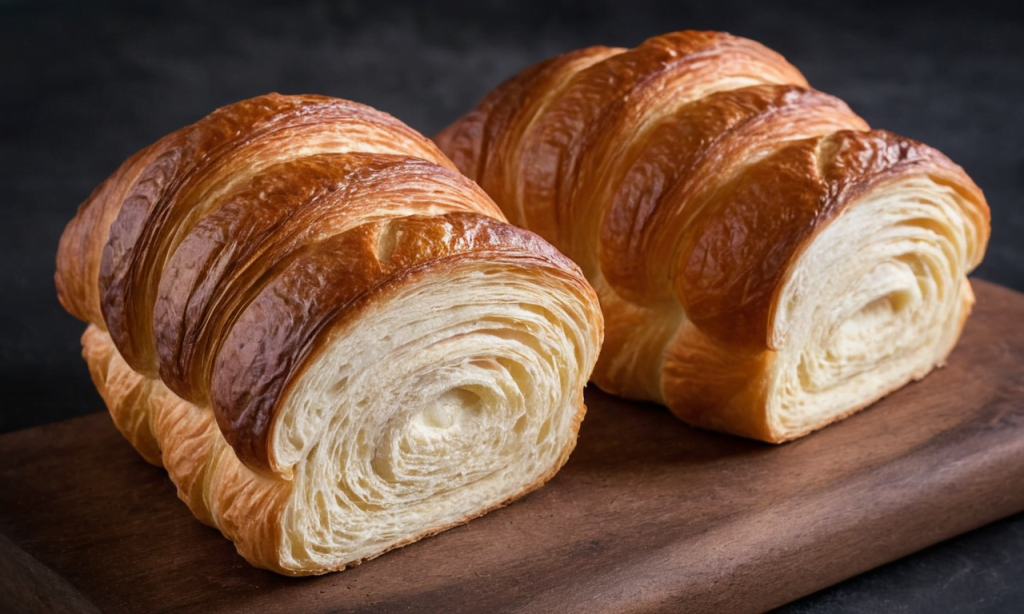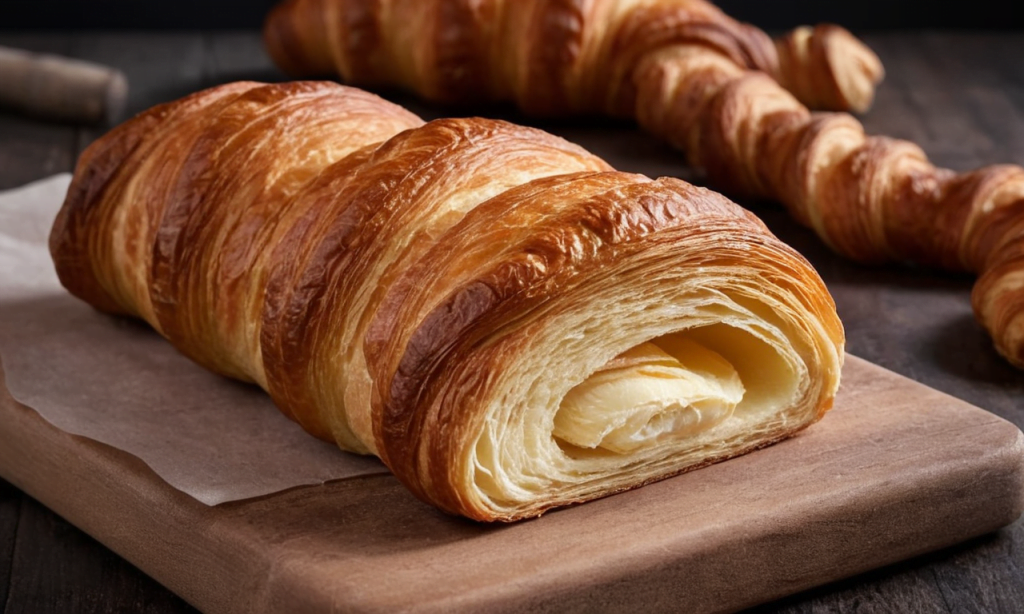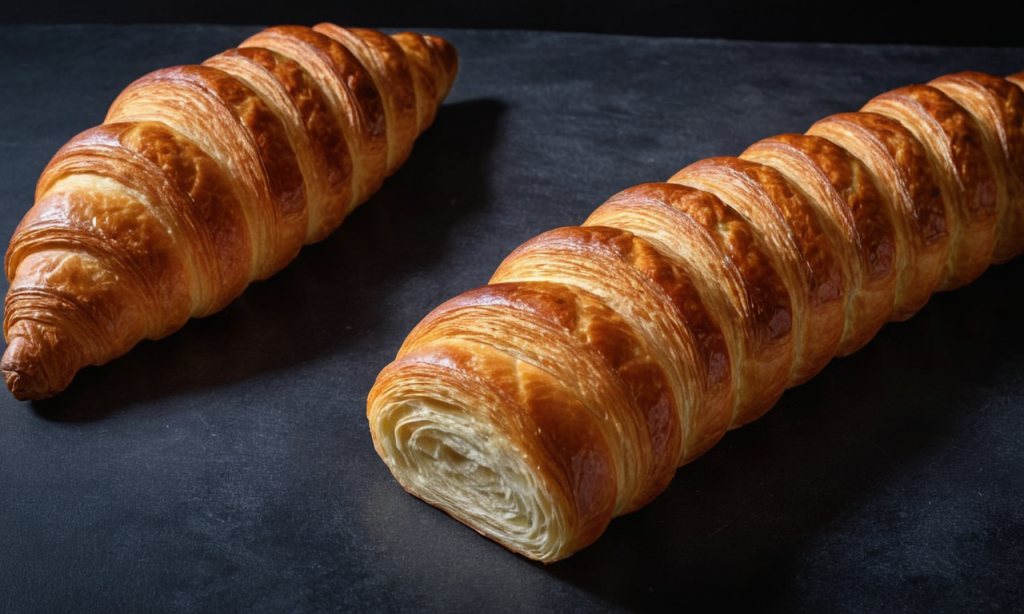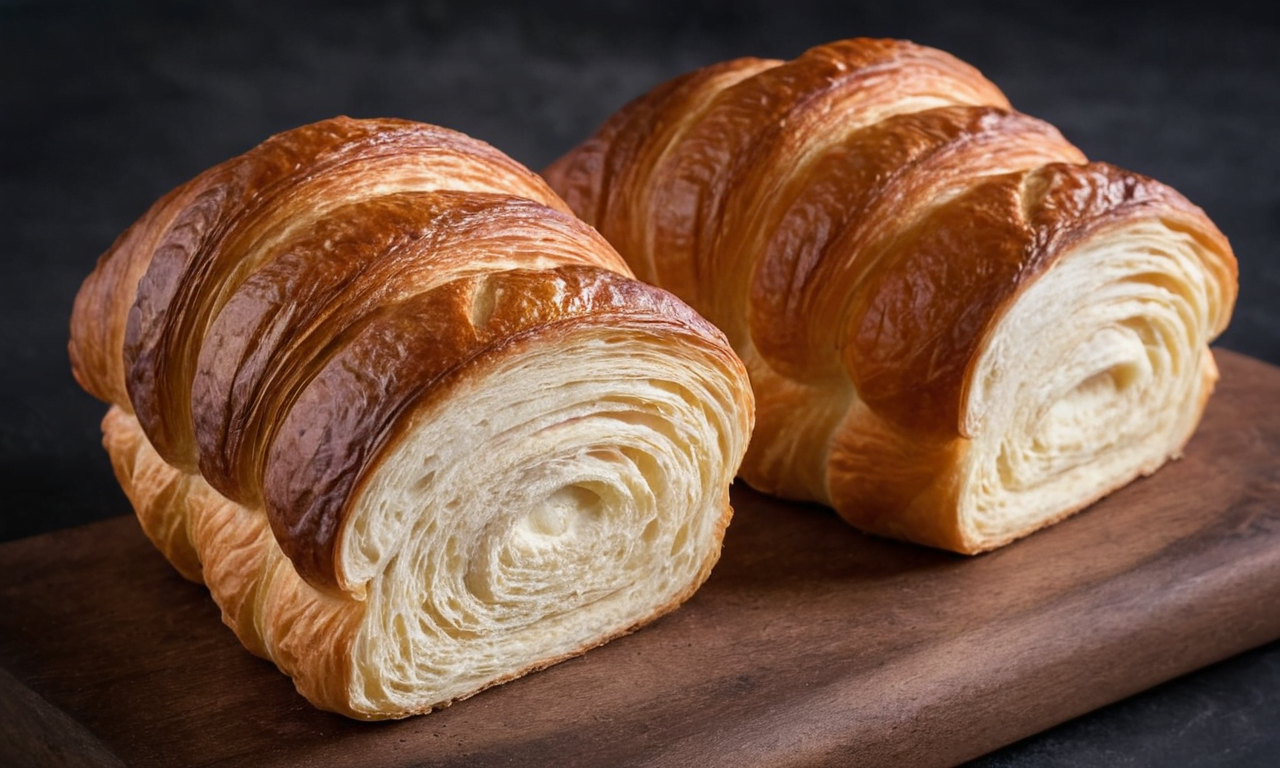Ah, the humble croissant bread! A marvel of the baking world that dances on the fine line between the flaky, buttery layers of a traditional croissant and the hearty, satisfying chew of freshly baked bread. This culinary delight has captured the hearts (and taste buds) of food enthusiasts far and wide, weaving its way into breakfast tables, brunch spreads, and the occasional midnight snack. But what’s the story behind this delectable treat, and how can you master the art of making it at home? Buckle up, dear reader, for we’re about to embark on a flavorful journey through the world of croissant bread, from its flaky crust to its soft, airy interior.
The Basics of Croissant Bread Baking: A Starter’s Guide

A Brief History
Once upon a time, in the labyrinthine lanes of old Paris, the croissant was born—a pastry of Austrian origin, reimagined by French bakers. Fast forward a few centuries, and the culinary world presents us with an innovative twist: croissant bread. This isn’t your average loaf, nor is it a mere croissant; it’s a harmonious blend of both, offering the best of both worlds.
The Evolution into Modern Kitchens
As the croissant bread made its way from artisanal bakeries to home kitchens, it evolved. Bakers, both novice and seasoned, began experimenting, infusing traditional recipes with contemporary twists—be it through the incorporation of whole grains, a dash of sweet or savory fillings, or even gluten-free adaptations. The result? A versatile loaf that’s as suitable for a lavish Sunday brunch as it is for a simple, comforting weekday breakfast.
The Technique Behind the Layers
At the heart of croissant bread lies the technique—laminating dough with butter to create those irresistible, flaky layers. It’s a dance of precision and patience, where the dough is folded and rolled with just the right amount of tenderness and care, ensuring that each layer remains distinct, ready to puff up into golden perfection in the oven.
In this first part of our exploration into croissant bread, we’ve just scratched the surface of its rich history and the meticulous technique behind its creation. Stay tuned as we delve deeper into the nuances of making this exquisite loaf, complete with tips, tricks, and a step-by-step guide to achieving bakery-level excellence in your own kitchen. Whether you’re a baking novice or a seasoned pro, the journey through the layers of croissant bread promises to be as delightful as the final product itself. So, roll up your sleeves and get ready to sprinkle a little flour magic into your baking adventures!
Lamination Techniques for Perfect Croissant Loaf Layers

Understanding Lamination
Lamination is the soul of croissant bread, a process that might seem daunting at first but is incredibly rewarding. It’s all about creating those buttery, flaky layers that make croissants and croissant bread so irresistible. The key? A harmonious blend of butter and dough, where neither overwhelms the other, but instead, they come together to create pastry magic.
Step-by-Step Guide to Perfect Lamination
- Preparing the Dough: Start with a smooth, elastic dough. Patience is your friend here, as the dough needs time to rest and develop its gluten structure. This isn’t just any old dough; it’s the canvas for your masterpiece.
- The Butter Block: The heart of lamination lies in the butter block. It should be pliable yet cold; too hard, and it’ll tear the dough, too soft, and it’ll ooze out. Aim for a consistency that’s just right, akin to the dough’s.
- The First Fold: Encase the butter block within the dough, sealing the edges with the finesse of a skilled artisan. Then, gently roll it out and perform the first fold, usually a three-fold or book fold. This is where the layers begin to form, each fold multiplying the layers and building the foundation for that flaky texture.
- Rest and Repeat: After each fold, the dough needs to rest. This isn’t idle time; it’s an essential chapter in the story of croissant bread, allowing the gluten to relax and the butter to chill. Repeat the folding process, usually 3-4 times, with resting periods in between. Each fold is a step closer to achieving the desired flakiness.
- Shaping and Final Rise: Once laminated, shape the dough into a loaf, tucking it into a pan that will guide its rise. The final rise is a slow, gentle process, allowing the layers to puff up, ready to spring into action in the hot embrace of the oven.
Common Pitfalls and How to Avoid Them
- Butter Breakthrough: If the butter breaks through the dough, it can disrupt the layers. To prevent this, ensure the butter is the correct consistency and handle the dough with care.
- Overworking the Dough: Handle the dough gently. Overworking can lead to tough croissant bread.
- Inconsistent Temperature: Keep the dough and butter cold, but not too cold. If the butter is too hard, it can tear the dough; if it’s too soft, it can melt into the dough.
Mastering the art of lamination might seem like a journey fraught with challenges, but it’s also filled with moments of joy, especially when you slice into your freshly baked croissant bread to reveal the intricate layers you’ve created. Remember, every baker has their own journey with lamination, each loaf a reflection of the care, patience, and love poured into it. So, embrace the process, learn from each fold, and soon, you’ll be crafting loaves that not only taste divine but are a feast for the eyes too. Stay tuned for the next part, where we’ll dive into the baking process, ensuring your croissant bread is nothing short of perfection.
The Baking Process – Achieving Golden Perfection

Preheating the Stage
The oven is more than just a kitchen appliance; it’s the stage where the croissant bread performs its final act. Preheating your oven is crucial; it needs to be just the right temperature to welcome the dough. Think of it as prepping the stage for the grand performance, where every degree counts.
Scoring the Loaf
Before the dough makes its grand entrance into the oven, it needs a little embellishment—a gentle scoring. This isn’t just for aesthetics; it guides the bread as it expands, allowing it to bloom gracefully. With a sharp blade in hand, etch your design with the lightness of a feather, careful not to deflate the masterpiece you’ve so painstakingly created.
Steam – The Unsung Hero
Steam plays a pivotal role in the baking process, especially in the initial minutes. It’s the unsung hero that keeps the crust soft during the early stages of baking, allowing the croissant bread to rise to its full potential before developing that iconic golden crust. A simple tray of water at the bottom of the oven can work wonders, creating an environment where your loaf can truly shine.
Baking to Perfection
As the croissant bread basks in the heat, a transformation occurs. The layers you’ve folded and nurtured begin to puff, each one distinct, coming together to form a symphony of texture and flavor. Keep a vigilant eye on the oven, as the line between golden perfection and overdone can be thin. The bread is ready when it boasts a deep golden hue, and its song, when tapped, is a hollow echo of readiness.
Cooling – Patience Rewarded
The journey doesn’t end as soon as the oven door opens. The croissant bread needs time to rest, to settle into its final form. Resist the temptation to slice into it immediately; cooling is a critical chapter in this story. It allows the structure to set, ensuring that each slice is as perfect as the last. A wire rack is your ally here, providing the airflow needed for the loaf to cool evenly.
Baking croissant bread is an art and a science, a dance of temperature, timing, and technique. Each step, from preheating the oven to allowing the loaf to cool, plays a crucial role in the final outcome. It’s a journey of anticipation, filled with moments of wonder as you watch the dough transform into a golden, flaky loaf. As we wrap up this part of our guide, remember that each loaf is a learning experience, a chance to refine your skills and deepen your connection with the art of baking. In the next part, we’ll explore creative variations and serving suggestions to elevate your croissant bread to new heights. Stay tuned, for the adventure continues!
Creative Variations and Serving Suggestions

Exploring Variations
Croissant bread is a canvas, waiting for the brushstrokes of your culinary creativity. While the classic version is a masterpiece in its own right, the potential for variation is boundless. Consider incorporating different types of flour, like whole wheat for a nuttier flavor or rye for a deeper, earthier note. Seeds and grains can add texture and visual appeal, while herbs and spices can infuse the loaf with aromatic layers.
Sweet and Savory Fillings
The layers of croissant bread are perfect for harboring fillings, transforming the loaf into a mosaic of flavors. For a sweet twist, swirls of cinnamon sugar, dollops of fruit jam, or even chocolate chips can turn each slice into a decadent treat. On the savory side, think of incorporating cheeses, sun-dried tomatoes, or pesto, creating a loaf that’s a meal in its own right.
Serving Suggestions
Croissant bread is incredibly versatile, making it a star player in various culinary settings. For breakfast, toast a slice to golden perfection and top it with a poached egg and a sprinkle of fresh herbs. At brunch, it can be the base for an extravagant French toast, soaked in a rich custard and served with a drizzle of maple syrup and fresh berries. And let’s not forget the simple pleasure of a slice of croissant bread with a smear of butter, where the bread’s natural flavors and textures take center stage.
Pairing with Soups and Salads
This bread isn’t just for breakfast or brunch; it can also play a supporting role in lunch or dinner. Pair a crusty slice with a bowl of creamy soup, using it to soak up every last drop, or serve it alongside a crisp salad, adding a satisfying crunch to your meal. The buttery layers of the bread complement both the lightness of the salad and the richness of the soup, making for a well-rounded dining experience.
As we delve into the world of creative variations and serving suggestions for croissant bread, it’s clear that this loaf is more than just a bread; it’s a medium for culinary expression. Whether you’re sticking to the classic recipe or venturing into the realm of sweet and savory fillings, croissant bread offers a unique opportunity to experiment and explore. In the next part, we’ll address some frequently asked questions, shedding light on common queries and offering tips to ensure your baking success. Stay tuned, as our journey through the delightful world of croissant bread continues!
Frequently Asked Questions (FAQs)
Q1: Why did my croissant bread turn out dense instead of flaky?
A1: A dense loaf can result from a few factors, such as overworking the dough, insufficient lamination, or not allowing enough resting time between folds. Remember, the key to flakiness lies in creating distinct layers of dough and butter, so be gentle with the dough and give it ample time to rest.
Q2: How can I ensure my butter doesn’t leak out during baking?
A2: Leaking butter is often a sign that the butter was too warm or the dough too thin during the final roll-out. Keep your butter cold (but pliable) and ensure your dough isn’t rolled out too thinly before baking. This helps maintain the integrity of the layers.
Q3: Can I make croissant bread without a stand mixer?
A3: Absolutely! While a stand mixer can make the process quicker, croissant bread can certainly be made by hand. It might require a bit more elbow grease, especially during the initial mixing, but the results can be just as satisfying.
Q4: How long can I store croissant bread, and how should I store it?
A4: Croissant bread is best enjoyed fresh, but it can be stored for up to 2 days at room temperature, wrapped in a clean cloth or in a bread box. For longer storage, wrap it well in plastic wrap and freeze for up to a month. Thaw and reheat in the oven for best results.
Q5: Can I use whole wheat flour to make croissant bread?
A5: Yes, you can incorporate whole wheat flour for a healthier twist, but it’s best to start with a mix of whole wheat and all-purpose flour to maintain the lightness of the bread. A good starting point is substituting one-third of the all-purpose flour with whole wheat flour.
Q6: My croissant bread didn’t rise much during the final proof. What went wrong?
A6: There could be several reasons for inadequate rise during the final proof, such as expired yeast, too cold of an environment, or not enough proofing time. Ensure your yeast is active, the dough is kept in a warm, draft-free area, and you give it enough time to double in size.
Q7: Can I add fillings to my croissant bread? If so, when?
A7: Yes, fillings can be a delightful addition! Add them during the final roll-out before shaping the loaf. Be mindful not to overfill, as this can hinder the layers from rising properly during baking.
Addressing these FAQs is crucial for both novice and experienced bakers, as it helps troubleshoot common issues and enhances the overall baking experience. With these tips and tricks, you’re well-equipped to tackle the challenges of croissant bread baking, ensuring each loaf is as delicious as it is beautiful. As we conclude this part, remember that baking is as much about the journey as it is about the destination. Each attempt brings new insights, leading you closer to your perfect loaf of croissant bread.
The Final Touch – Presentation and Enjoyment
Elevating Your Presentation
The beauty of croissant bread lies not only in its taste and texture but also in its presentation. A well-baked loaf, with its golden crust and flaky layers, is a sight to behold. To elevate your presentation, consider a light dusting of powdered sugar for sweet variations, or a sprinkle of coarse sea salt and herbs for savory ones. Serve it on a wooden cutting board for rustic charm, or a sleek, modern plate for a more refined look.
Pairing with Beverages
The perfect beverage can complement and enhance the flavors of croissant bread. For a classic breakfast, pair it with a hot cup of coffee or tea, allowing the warmth of the beverage to meld with the buttery layers of the bread. Indulgent treat, a glass of cold milk or a rich hot chocolate can turn a simple snack into a comforting delight. And lastly savory versions, consider a light, crisp white wine that won’t overpower the delicate flavors of the bread.
Sharing the Joy
Croissant bread is more than just food; it’s an experience best shared with others. Whether it’s a family breakfast, a brunch with friends, or a simple gathering, sharing a loaf of croissant bread can turn a meal into a memorable occasion. The act of breaking bread together, of sharing slices of this flaky, buttery loaf, can bring people closer, creating moments of joy and connection.
Mindful Enjoyment
In our fast-paced world, it’s easy to forget the importance of savoring our food. When enjoying croissant bread, take a moment to appreciate the aroma, the texture, and the flavors. Notice the flakiness of the layers, the softness of the interior, and the crispness of the crust. Mindful eating enhances the experience, turning each bite into a moment of true enjoyment.
As we conclude our journey through the world of croissant bread, from its origins and techniques to its baking, variations, and enjoyment, it’s clear that this is more than just a recipe—it’s a labor of love. Each step, from the careful lamination to the final presentation, is a testament to the art of baking. So, the next time you set out to bake a loaf of croissant bread, remember that you’re not just making bread; you’re creating an experience, one that’s meant to be savored, shared, and enjoyed to the fullest. Happy baking!

